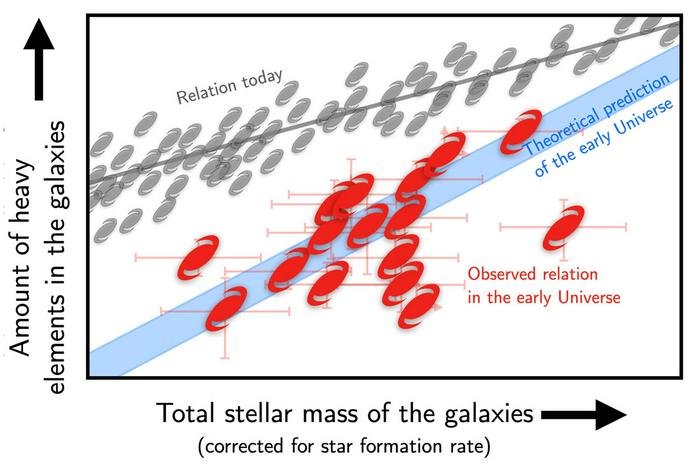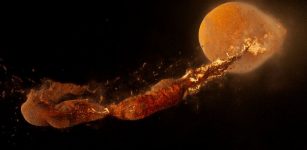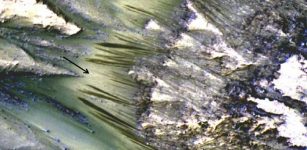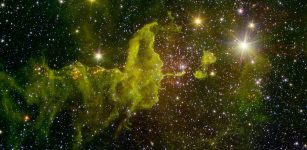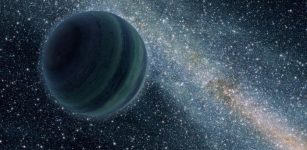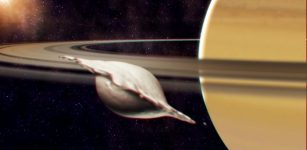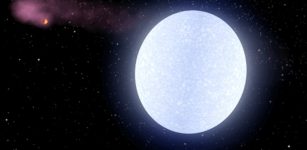Astronomers And James Webb Telescope Observe Creation Of The First “Unpolluted” Galaxies
Eddie Gonzales Jr. – MessageToEagle.com – Using JWST, astronomers can now peer back in time and approach the epoch when the first galaxies were probably created.
The James Webb Space Telescope (JWST) is a space telescope specifically designed to conduct infrared astronomy. It is a field of study in astronomy that specializes in observing and analyzing astronomical objects using infrared (IR) radiation.
The big galaxy in the foreground is named LEDA 2046648, and is seen just over a billion years back in time, while most of the others lie even farther away, and hence are seen even further back in time. ESA/Webb, NASA & CSA, A. Martel.
JWST has high-resolution and high-sensitivity instruments that allow it to view objects that are too old, distant, or faint for the Hubble Space Telescope.
In most of the history of the Universe, galaxies seem to follow a close relationship between how many stars they have formed and how many heavy elements (means everything heavier than hydrogen and helium) they have formed. Initially, the Universe consisted only of these two lightest elements. All other heavier elements, such as carbon, oxygen, and iron, were created later by the stars.
But for the first time, astronomers see signs that this relationship between the amounts of stars and elements does not hold for the earliest galaxies.
The reason is probably that these galaxies are simply in the process of forming and have not yet had time to form heavy elements.
The Universe is packed with galaxies — enormous collections of stars and gas — and as we look deep into the cosmos, using our best telescopes, we see all these celestial bodies – near and far. However, as the light has spent more time reaching us, the farther away a galaxy is located, it means we are, in effect, looking back through time. It gives us an outstanding possibility to construct a visual narrative of these galaxies’ evolution throughout the history of the Universe.
According to astronomical observations, galaxies -through the last 12 billion years (5/6 of the Universe’s age) age of the Universe – have lived their lives in equilibrium. This concept of equilibrium is of great importance for astronomers during the observations of galaxies. The galaxies, however, are not in any equilibrium state when they form and keep being upset by infalling gas and galaxies.
Diffuse gas from intergalactic space plummets toward the center, sparking star formation and becoming part of the galaxy’s rotating disk. When stars die, they return their gas to the galaxy (and the intergalactic space), now enriched with heavy elements. Image credit: CTumlinson et al. (2017).
The state of equilibrium they have to obtain with time and during the long process, in which equilibrium can often be upset (interrupted) because of a merger with another galaxy, for example. Undergoing such a disturbing process, some driving force is causing the state of the galaxy’s system to change.
James Webb Is The Best We Have
This telescope will look much deeper. It is the largest, most powerful space telescope ever built. It will allow scientists to look at what our universe was like about 200 million years after the Big Bang.
The very first galaxies should, therefore, be pure – totally “unpolluted” by heavy elements.
To look for the most distant galaxies, astronomers must look all the way into the infrared part of the spectrum. Now, it can be made by James Webb, which can detect objects up to 100 times fainter than Hubble can.
But until recently, we haven’t been able to look so far back in time. In addition to being far away, the reason is that the longer light travels through space, the redder it becomes. For the most distant galaxies you have to look all the way into the infrared part of the spectrum, and only with the launch of James Webb did we have a telescope big and sensitive enough to see so far.
James Webb Telescope Did Not Disappoint
In a new study published today in the scientific journal Nature Astronomy, a team of astronomers from the Danish research center Cosmic Dawn Center at the Niels Bohr Institute and DTU Space in Copenhagen, has discovered what seems indeed to be some of the very first galaxies which are still in the process of being formed.
This plot shows the observed galaxies in an “element-stellar mass diagram”: The farther to the right a galaxy is, the more massive it is, and the farther up, the more heavy elements it contains. The gray icons represent galaxies in the present-day Universe, while the red show the new observations of early galaxies. These ones clearly have much less heavy elements than later galaxies, but agree roughly with theoretical predictions, indicated by the blue band. Image credit: Credit: Kasper Elm Heintz, Peter Laursen.
“Until recently it has been near-impossible to study how the first galaxies are formed in the early Universe, since we simply haven’t had the adequate instrumentation. This has now changed completely with the launch of James Webb,” says Kasper Elm Heintz, leader of the study and assistant professor at the Cosmic Dawn Center.
The relationship between the total stellar mass of the galaxy and the amount of heavy elements is a bit more complex than that, astronomers say. How fast the galaxy produces new stars also has something to say. But if you correct for that, you get a beautiful, linear relationship: The more massive the galaxy, the more heavy elements.
But this relation is now being challenged by the latest observations.
“When we analyzed the light from 16 of these first galaxies, we saw that they had significantly less heavy elements, compared to what you’d expect from their stellar masses and the amount of new stars they produced,” says Kasper Elm Heintz.
In fact the galaxies turned out to have, on average, four times less amounts of heavy elements that in the later Universe. These results are in stark contrast to the current model where galaxies evolve in a form of equilibrium throughout most of the history of the Universe.
Predicted By Theories And Now Observed
The result is not entirely surprising though. Theoretical models of galaxy formation, based on detailed computer programs, do predict something similar. But now we’ve seen it!
The explanation, as proposed by the autors in the article, is simply that we are witnessing galaxies in the process of being created. Gravity has gathered the first clumps of gas, which have begun to form stars. If the galaxies then lived their lives undisturbed, the stars would quickly enrich them with heavy elements.
Based on the original story
Written by Eddie Gonzales Jr. – MessageToEagle.com Staff



